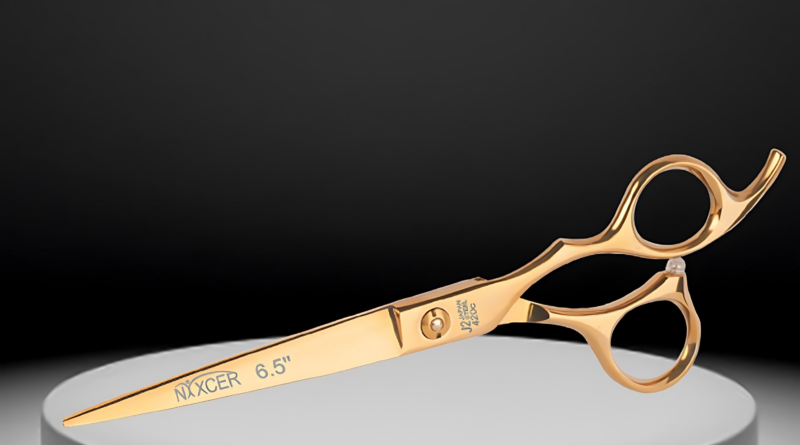How to Clean and Disinfect Your Professional Hair Cutting Scissors
Hair cutting scissors are one of the most essential tools in the professional hairstylist’s kit. Whether you’re working in a salon, at home, or in a barber shop, your professional hair cutting scissors are the key to achieving precision, cleanliness, and consistency in every haircut. However, these high-quality tools require proper care, including regular cleaning and disinfection, to ensure that they remain sharp, efficient, and safe to use.
Just like any other tool used in a professional setting, hair cutting scissors can accumulate dirt, hair, oil, and other debris. In addition to maintaining sharpness and precision, proper cleaning and disinfection are vital for the safety of both the stylist and the client. This article will explore the steps and best practices for cleaning and disinfecting your professional hair cutting scissors, ensuring that they remain in peak condition and free from harmful bacteria or germs.
1. Why Cleaning and Disinfecting Your Hair Cutting Scissors Is Important
Your professional hair cutting scissors are in constant contact with hair, skin, and sometimes even styling products like gels, sprays, or oils. Over time, these substances can build up on the scissors, affecting their performance and hygiene. Here’s why cleaning and disinfecting your scissors regularly is essential:
a. Preventing Bacteria and Germs
Hair, skin, and styling products can trap bacteria and other harmful microorganisms. If not properly cleaned and disinfected, your scissors can become a breeding ground for these germs. Disinfecting your scissors helps prevent the spread of bacteria, fungi, and viruses, especially in a shared environment such as a salon or barbershop.
b. Maintaining Scissor Performance
Over time, hair and styling products can create a sticky residue on the blades, which can cause your scissors to become dull or difficult to use. Proper cleaning removes this residue, ensuring that the scissors continue to cut smoothly and cleanly.
c. Prolonging the Life of Your Scissors
Routine cleaning and disinfection not only ensure hygiene but also contribute to the longevity of your professional hair cutting scissors. By keeping them free from debris and residue, you reduce the risk of damaging the blades, rusting, or other wear and tear that could result from improper care.
2. Essential Tools and Products for Cleaning and Disinfecting Hair Cutting Scissors
Before you start the cleaning and disinfection process, it’s important to gather the proper tools and products. Here’s what you’ll need:
a. Soft Cloth or Microfiber Towel
A soft cloth or microfiber towel will help you wipe off any hair, oil, or residue from the blades and handles without scratching or damaging the surface. Microfiber towels are particularly effective at picking up dust and debris while being gentle on the scissors.
b. Scissors Cleaning Solution
There are specially formulated cleaning solutions available for professional hair cutting scissors that help remove grease, dirt, and residue. You can also use a mild dish soap and warm water solution as an alternative, but make sure it is safe for metal tools.
c. Disinfectant Spray
A high-quality disinfectant spray or wipe is necessary for killing germs and bacteria. It’s essential to choose a disinfectant that is safe for metal tools and will not cause rusting. Make sure it’s designed specifically for professional use in salons or barbershops.
d. Lubricant Oil
After cleaning and disinfecting, it’s important to lubricate your scissors to ensure that they continue to operate smoothly. Scissor oil or a light machine oil can help reduce friction, preventing the scissors from becoming stiff or hard to open and close.
e. Small Brush
A small brush (like a toothbrush) can help you clean the spaces between the blades, joints, and other hard-to-reach areas of the scissors.
f. Compressed Air (Optional)
Using compressed air can help blow out any trapped hair or dust in the crevices of the scissors, especially around the pivot point.
3. Step-by-Step Guide to Cleaning and Disinfecting Your Professional Hair Cutting Scissors
Now that you have your tools ready, here’s a step-by-step guide on how to properly clean and disinfect your professional hair cutting scissors.
Step 1: Remove Hair and Residue
The first step in the cleaning process is to remove any hair, oil, or other residues from the blades and handles.
- Wipe the Blades: Using a soft cloth or microfiber towel, gently wipe the blades of the scissors. This will remove any loose hair, dirt, or product residue.
- Brush Between the Blades: Use a small brush (like a toothbrush) to get into the nooks and crannies between the blades. These areas can trap hair and buildup, so it’s important to clean them thoroughly. Be careful not to scratch or damage the blades.
- Use Compressed Air: If you have compressed air, use it to blow out any dust, hair, or debris from the joints and pivot point of the scissors. This can help dislodge anything that’s stuck inside.
Step 2: Clean with Soap or Cleaning Solution
Once you’ve removed most of the surface debris, it’s time to clean the scissors with a solution to remove any remaining oils and sticky residue.
- Prepare the Solution: If you’re using a mild soap and warm water solution, mix it in a small bowl. Alternatively, use a commercial scissors cleaning solution that’s safe for metal tools.
- Clean the Blades: Dip a cloth or soft sponge into the solution and gently wipe the blades. Make sure the solution doesn’t come in contact with the handle excessively, as it may cause the handles to lose their finish or rust over time.
- Dry the Scissors: Immediately after cleaning the blades, dry them thoroughly using a microfiber towel. Leaving the scissors damp could lead to rust and corrosion, which will reduce the lifespan of your scissors.
Step 3: Disinfect the Scissors
Disinfection is crucial, especially if the scissors are being used by multiple people or in a busy salon or barber shop environment.
- Apply Disinfectant: After cleaning the scissors, apply a disinfectant spray or wipe to the blades and handles. Make sure the disinfectant is safe for metal and does not leave harmful residues.
- Allow Time to Disinfect: Leave the disinfectant on the scissors for the recommended amount of time as indicated on the product instructions. This ensures that the disinfectant has enough time to kill any bacteria, fungi, or viruses that may be present.
- Wipe Excess Disinfectant: Once the disinfectant has had time to work, use a clean cloth to wipe away any excess. This prevents any chemical residue from being left on the scissors, which could affect their performance or safety.
Step 4: Lubricate the Scissors
Lubricating your professional hair cutting scissors after cleaning is crucial to ensure they continue to perform at their best. The lubrication helps reduce friction between the blades and the pivot point, which improves their cutting ability and prevents the blades from sticking.
- Apply Lubricant: Apply a small amount of scissor lubricant or light machine oil to the pivot point of the scissors. Open and close the scissors several times to work the oil into the mechanism.
- Wipe Away Excess Oil: Use a cloth to wipe away any excess lubricant, ensuring that the scissors don’t become slippery or messy.
Step 5: Store the Scissors Properly
After cleaning and disinfecting your scissors, it’s important to store them properly to prevent damage.
- Use a Scissor Case: Store your scissors in a padded case or protective sleeve when not in use. This helps protect the blades from being damaged or scratched.
- Avoid Storing in Damp Areas: Never store your professional hair cutting scissors in a damp or humid area, as this can cause rusting and corrosion over time.
- Keep Away from Harsh Chemicals: Keep your scissors away from harsh chemicals or products that could damage the metal or finish.
4. Best Practices for Maintaining Your Hair Cutting Scissors
In addition to regular cleaning and disinfecting, there are a few other maintenance practices to follow to ensure the longevity of your professional hair cutting scissors:
- Sharpen Regularly: Regularly sharpen your scissors to maintain their precision. A dull pair of scissors can damage hair, leading to split ends and uneven cuts.
- Check Tension Regularly: The tension screw of your scissors should be adjusted regularly to ensure smooth cutting action. A screw that’s too tight can strain the blades, while one that’s too loose can make cutting less precise.
- Avoid Dropping the Scissors: Dropping your scissors can damage the blades or the pivot point, affecting their cutting ability. Always handle your scissors carefully to avoid accidental drops.
5. Conclusion
Maintaining the cleanliness and hygiene of your professional hair cutting scissors is essential to their performance and longevity. Regular cleaning and disinfecting not only help keep your scissors sharp and effective but also protect both you and your clients from harmful bacteria and germs. By following the steps outlined in this article and using the right tools and products, you can ensure that your scissors remain in top condition, providing smooth, precise cuts for years to come.
Remember, a well-maintained pair of hair cutting scissors is an investment in your craft, and proper care will allow you to deliver the best results for your clients while also preserving the quality of your tools.




